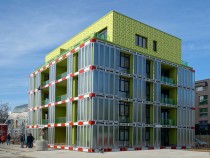Microalgae are one of the most promising components of alternative energy scenarios today because they transform sunlight into biomass in a particularly efficient way. Like other plants, microalgae use sunlight to perform photosynthesis, a process that takes carbon dioxide out of the atmosphere. However, microalgae are more efficient at this than higher plant species because they are unicellular organisms and thus every cell in a microalgae colony performs photosynthesis.In contrast to energy crops such as corn, the growth of microalgae does not use up additional agricultural land and therefore does not compete with food production. Moreover, the cultivation of microalgae is not dependent on weather conditions and intensive farming methods. Microalgae can be grown in photobioreactors (PBR). These are sealed, transparent containers filled with a cultivating medium that can even be installed in places that are otherwise too dry or barren – including the centres of large cities. These advantages of microalgae led to the development of Germany’s first photobioreactor facade based on this type of microorganisms. This article describes the function of the façade and its components, as well as their integration into the a first prototype building in Hamburg. (Jan Wurm)






